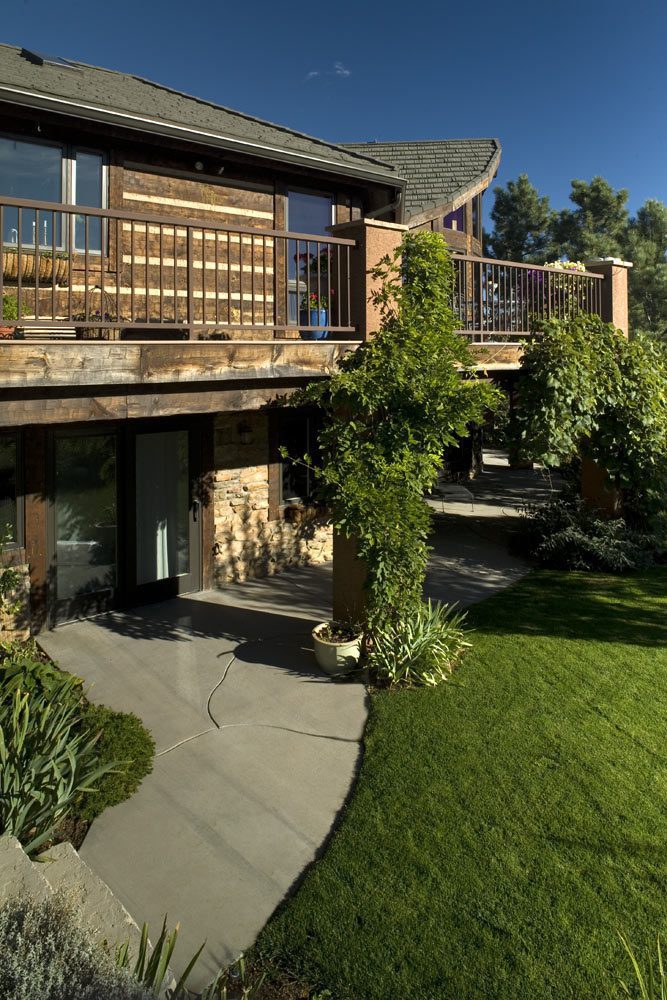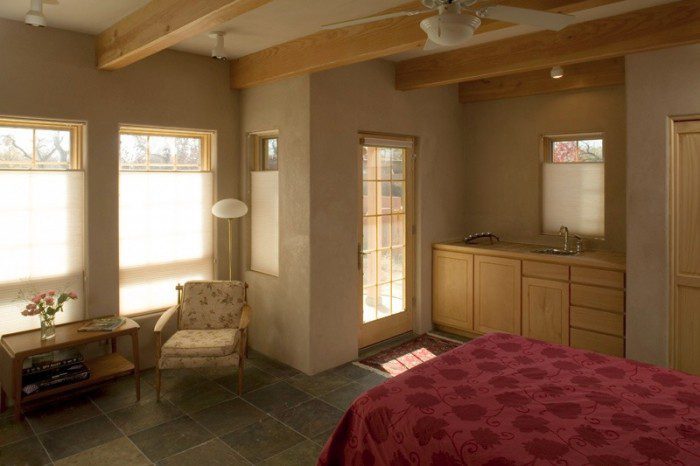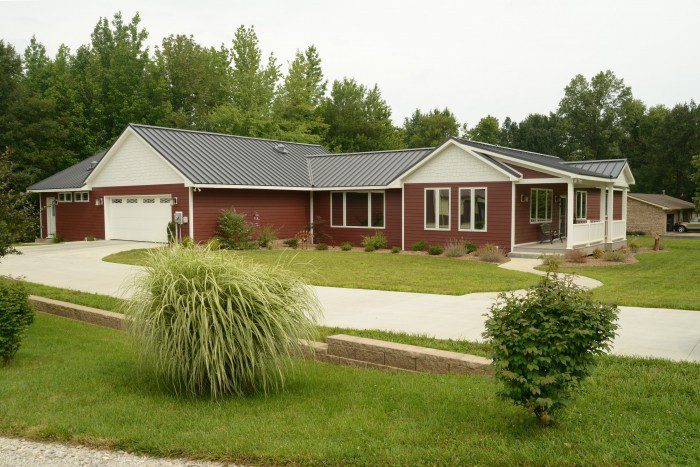
When we first went into business in 1975, we were a local (Albuquerque, New Mexico) passive solar home design and building company and built every home we designed. After becoming experienced and proficient with green home building, we expanded our design services and let the building portion of the majority of our projects go to other green home builders. We have stayed current on our building skills by occasionally building select local projects.
An important aspect of working with a builder that is often overlooked by clients is the builder’s fee and accounting structure. Two very common methods that contractors will use are the bid method and cost-plus-a-percentage (cost plus). Both of these arrangements can work well with an honest builder, but they have built-in incentives for the builder that work against the best interests of the clients. When we build homes, we prefer the cost-plus-a-fixed-fee and open books arrangement. Cost-plus-a-fixed-fee is the most straightforward, simple and fair system we have found for building a custom home. In this agreement, the homeowner pays for the materials (at the contractor's price with no markup), the labor to build the home and also a set salary for the contractor that is fair and reasonable. More on this in a moment.
The Bidding Method
Many builders still use the bidding method when they build a new custom home. With the bid method, a builder will either get bids or estimates from his subcontractors or he will use his own rules-of-thumb to arrive at reasonable costs for the various labor and materials needed for the project—plumbing, electrical, flooring, cabinets, fees, permits, etc. He will add his profit and overhead AND a contingency fee to cover anything he might have missed. The contingency is usually about 10%, unless there are concerns that the project might go over budget for any reason, in which case the builder might add more. His bid is the total of all these numbers and is usually presented in a lump sum to the homeowner; not itemized. Usually a homeowner receives bids from a few builders before choosing the builder to build their home. For a builder, bidding takes quite a bit of time, so bids can vary widely, both in the manner in which they are calculated and in the total amount.
There are some significant problems with the bidding method. First of all, the numbers are only as good as the math that produced them. If the bid is way more than necessary, you pay for it. If it's way lower than it actually costs to build.....well, you can still end up paying for it, unfortunately.
Once a set price has been agreed upon for the construction of a home, there is a built-in incentive (unfortunately) for the builder to be as frugal as he can be during construction. If the actual costs are less than the bid, the balance goes to the builder! Most builders are reputable, but you can see how this could work against your goals as the homeowner.
There are many steps to building a home, and in many cases there is the fast and easy way, then there is a better way that might make the home more energy efficient, or might reduce maintenance later. The better way usually costs more time or money. When the homeowner does not know any better and it makes a difference to the contractor's bottom line, what will the contractor do?
If the project goes well and the contingency is not used, all the better for the builder! This money is not returned to the homeowner— in fact the homeowner rarely knows of its existence. If the project runs into unexpected trouble and the contingency is eaten up, the contractor will start to get nervous. If the project becomes a real problem and the contractor starts to lose money, service and quality can fly out the window. This is where some of those horror stories, that we have all heard, come from.

Sometimes builders, in an effort to get new work, bid a job too low. In this case they can run out of money before the project is finished. Several bad things can result from this. We have heard stories of builders taking on other work to help defray costs, thereby leaving the underbid project with very little supervision or quality control. Others have just packed up and left town with no forwarding address, leaving the homeowner with an unfinished home. Usually, however, the builder sticks it out and does the best he can, but if he's losing money on your project, you can imagine what his attitude will be. The bidding method is a gamble and does not offer predictability or security to anyone involved.
Cost-Plus-A-Percentage
Sometimes the cost-plus-a-fixed-fee method is confused with cost-plus-a-percentage, sometimes referred to as cost plus. With cost-plus-a-percentage, the builder bids out or estimates all the different sub contractor’s fees and gives a reasonable allowance for the different finish materials, appliances, light fixtures etc. Once construction starts, the builder marks up all the labor and material invoices by a set percentage. A good aspect of this arrangement, similar with the cost-plus-a-fixed-fee method, is that everything is open books. The problem with this arrangement is that there is no incentive for the builder to try to keep costs down because the more construction costs, the more money they make. Most builders are reputable and honest and will not take advantage of their customers, but we feel that it is better not to structure their fee in such a way that creates a conflict of interest. Cost-plus-a-percentage is not our preferred fee structure.
Cost-Plus-A-Fixed-Fee
The cost-plus-a-fixed-fee method is by far our preferred way to work with clients. The way this works is the homeowner and the builder agree on a fixed fee that the builder will be paid for acting as the General Contractor on the project. Several factors are considered when determining the fee: the estimated construction cost of the home, its size and the complexity of the project, the weather, the driving time to the project site, the proximity to building materials and the local building climate, to name a few. It’s not uncommon for the builder to set their fee as a percentage of the construction costs. The percentage they use to arrive at their fee will be determined based on the above factors. The main difference between this and the cost plus method is that once the fee is set, changes that do not effect the amount of work for the builder, do not effect their fee. For example, if the client was given an allowance for flooring and is able to find some great material on sale, the builder isn’t penalized for this. Conversely, if the client ends up deciding on a more expensive flooring than was originally estimated, they are not penalized for this in the form of a higher builder’s fee. Cost-plus-a-fixed-fee creates for both the clients and the builder the fewest conflicts of interest and helps ensure that everybody works together honestly and that upon completion of the home, everybody feels they were treated fairly.
The bottom line is that you want to pay your builder a fair price for their work. The contractor's role in the project is a crucial one and there is a reason that it is a profession. Many people think they can do this job themselves and save money. Many get into it and realize there is much more to it than meets the uneducated eye. A good contractor identifies potential problems before they become a problem and can tell by inspecting the subcontractor's work if there is something that needs correcting. Fixing problems that do arise (and there are always some) at the right time is MUCH less expensive than discovering them once the home is completed. Your contractor will make or break the building project and should be paid for his/her skill and experience.
Contractor Fees
In our experience, the national average for contractor fees is 15% of the estimated construction cost of the home, but it can range from 6% to 25% depending on the specifics of the project. If you are a Sunlight Homes’ client, we can help you negotiate the fee with your builder.
Once you have negotiated this fee, your builder knows that he will be paid fairly for his work and it will not be a gamble. He has no incentive to cut corners. You know that your new home will cost the contractor fee, plus the actual cost of materials and labor. It's that simple. The builder still has an incentive to work efficiently on your project because this will allow him/her to finish your job in a timely fashion and move on to other projects. The more projects builders can do in a year, the more they make.
In every well run project there also needs to be an element of trust and respect between the parties involved. It's important to feel comfortable with the builder that you choose. If you are successful in this regard, the cost-plus-a-fixed-fee approach adds predictability to the building process.
Open Books
To continue the clean, straightforward approach to building your home, we also highly suggest an open books arrangement. When we build our homes locally, we use open books with our customers and always get great reviews from our clients. Here's how we do it.
Separate Checking Account
For every new project, we open a new, separate checking account. All financial transactions move through this account. All invoices are open to both parties who each have access to the bank account online and all the invoices. This way we all know where every dollar goes.
Some of our clients have decided to pay the bills themselves and we have handled it for others. If you decide to pay the bills, it's important that you pay them under the direction of your builder. You do not want to pay a subcontractor before they have completed the work and the work has been inspected and approved by your contractor. Because of this, it's usually easier to have the builder pay the bills.
Builder Discounts + Extra Costs

In this agreement, you, the homeowner, get the builder discounts on materials and builder pricing for labor. The builder is being paid a fixed fee and does not mark up anything more. As a result, the customer gets the discounts.
The flip side is that the homeowner also pays the extra if there are any problems during construction. Sometimes a product is not available and another, more expensive product, is the best option. Occasionally extra fees are needed for special permits or engineering tests. Expect a few of these unexpected costs during the construction of a custom home and you will not be surprised.
We think that the advantage of having a clean, open arrangement that passes on the builder's costs and eliminates the builder's contingency fees more than makes up for the occasional additional costs the customer has to pay to solve a problem during construction. These are, after all, part of the true cost of a custom home.
Win/Win
If you choose a decent, honest, builder you will find these financial arrangements to be clean and easy and they will give you the best chance of paying a fair price for your home. Using these methods, your builder will not have an incentive to downgrade components or the need to hire unskilled labor to recoup money on an underbid project. He or she will be more in line with your best interests, knowing they are receiving fair compensation.
